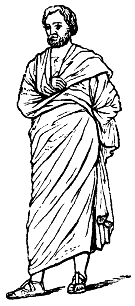Here I suggest how Mark might have used costumes to communicate the roles of Jesus’s enemies to the audience during the performance of the play that underlies the Gospel of Mark. The social identities or personal names of these persons were not spoken. Instead, the audience was shown something visually distinctive that identified the role. I assume that Mark observed the basic rule of playwriting: “Show, don’t tell.”
The enemies of Jesus in the Gospel of Mark
In the narrative text of the Gospel of Mark, Jesus’s enemies are named as follows: Pharisees, scribes, Herodians, elders, chief priests, the high priest. There is also one of his followers, Judas. I present them in order of their appearance, beginning with scribes in Mark 2:6.
The scribes were the intellectuals of the Pharisees. I suggest that in the play, both scribes and Pharisees wore a distinctive fringed garment: the himation, or standard cloak, with four tassels. These fringes were identificatory of Pharisees because fringes were specifically commanded in Deuteronomy 22:12 “You shall make tassels on the four corners of the cloak with which you cover yourself.” (Today this garment is known as a tallis/tallit and is worn by by observant Jews during morning prayers.*) The scribes would also carry a pen case or a small scroll.

*Not incidentally, today’s Jews are descendents of the Pharisees and scribes.
When the scribes are accompanied by actors wearing a fringed himation who do not carry the pen case/scroll (2:16), the audience will infer that these companions are Pharisees. (Note: the scribes/rabbis of the Talmud were active in Mark’s time (90s) in Judea/Galilee. However, Mark’s play is set some 60 years earlier. As the Temple was still in operation, the Pharisees were arguably considerably less popular among the peasantry than they would be a century later. So the fringed garment was distinctive of a Pharisee or scribe to both the world of the play and the world of the audience.)
The Pharisees consult with the Herodians (3:6). The Herodians have no distinctive qualities and are not members of the Council. They were probably not original; they were added by an editor. (Also, the Flavian court had welcomed the Herodian family: the pro-Roman Herod Agrippa II and Berenice. Mark would not have insulted them by portraying “Herodians” as Jesus’s enemies.)
Mark introduces chief priests in 11:18. They conspire with the already identifiable scribes. The chief priests mentioned in the narrative were very likely Sadducees. I don’t know if in the world of the audience Sadducees used a fringed himation. In any case, their costumes showed their wealth, and they used arrogant body language.
The next group to be introduced is the elders. In 11:27 they are walking in the Temple with the (already identifiable) scribes and the chief priests (Sadducees). The audience needs a visual cue to infer that they are a different group. Perhaps these actors have grey hair or carry canes. (By the way, “a different group” was 2-3 actors.)
Now, having identified these groups to the audience, Mark has most of them address Jesus in the Temple: 12:13 Pharisees and Herodians, 12:18 Sadducees, 12:28 scribes. Jesus can now condemn “scribes” in dialogue at 12:35-40, and the audience knows who he means.
In 14:10, a disciple sneaks away to to speak to the chief priests. The audience has already identified the chief priests as enemies of Jesus. The disciple must also be an enemy of Jesus. (Note: it is possible that this actor was originally onstage as an associate of the Pharisees, before he ‘joined’ Jesus’s followers. Now his true motivation becomes apparent.)
The servant of the high priest
How does the audience know that the arrest party includes the servant of the high priest and not the high priest himself? Both master and slave would have worn fine garments. And the Roman audience would not have been able to decipher the actor’s slave status by recognizing “what is missing” from the garments of the slave.

I think that Mark handled this problem in this way: The high priest is already (quietly) seated/enthroned in another part of the stage, visible but not yet part of the action. That is, the arrest is Stage Right, in the garden; the high priest is (appropriately) seated Stage Center, where the trial will take place. The audience infers that the similarly costumed actor in the arrest party is not the high priest himself.
Conclusion
Basic playwriting craft is “show, don’t tell.” If the Gospel of Mark was originally a play, this is how Mark would have handled identification of Jesus’s enemies. Most of the other characters in the play are also identified visually. In my book, The Two Gospels of Mark: Performance and Text, I note (p. 82) “the play could be performed with only the following names spoken onstage: Jesus, John (the Baptist), Satan, Peter, Boanerges, (Pontius) Pilate, Barabbas, and Joseph (possibly also Bar Matthias).” To learn more how Mark managed to introduce the other characters, and the surprising absence of the disciples’ names, read the book.
Revised December 23, 2022